| (insert your NIE or newspaper logo here) |
Weekly Online LessonOnline Lesson ArchiveGrade Level: 6-12
|
On the Road
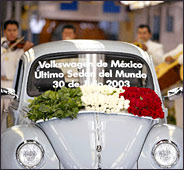 Wednesday,
July 30, 2003 marked the end of an era. Volkswagen Beetle number 21,529,464,
the last of its kind to be manufactured, rolled off the production line
in Puebla, Mexico.
Wednesday,
July 30, 2003 marked the end of an era. Volkswagen Beetle number 21,529,464,
the last of its kind to be manufactured, rolled off the production line
in Puebla, Mexico.
This global icon of automobiles, also known as the VW Bug, was initially the vision of Adolf Hitler 70 years ago. To help relieve unemployment, the Volkswagen, or "people's car," would be mass-produced and affordable for the working class plus more roads would be built.
Since World War II, the beetle's popularity has spread worldwide. In 1973, the beetle became the longest-produced car model, surpassing that of the Model T Ford with 16.5 million in its 19-year history. In 1992, the VW bug celebrated another milestone: The world automobile production record of 21 million vehicles.
The United States banned the bug in 1977 because the car's rear, air-cooled engine doesn't pass safety and emission standards. Regardless, thousands of beetles roam America's roads driven by bug lovers everywhere.
The VW Beetle isn't the only auto to make an impact on American culture, though. In fact, it's been said that America has had an intense love affair with the automobile for over a century, shaping our history, culture and environment. People travel hundreds of miles by car for recreation and business, classic car shows and street races can be found nearly everywhere, billions of gallons of gasoline are burned annually, and roads weave across the landscape like a spider's web.
As you'll discover in this week's lesson, America's desire for easy traveling, fast-paced racing and daily convenience quickly boosted the popularity of motor vehicles. You'll dig into the history and development of automobiles, including some Ford and Chrysler models, and meet their inventors. You'll also compare owning a car today with what it was like in 1919, with a look at how highways contributed to the spread of auto use in this country.
History of the Automobile
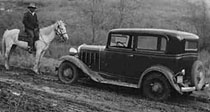 In
the 1890s, horse-powered work was just that — transporting goods
and plowing fields with horses. When the motor car began appearing on
the roads alongside horse-driven carriages, people had mixed feelings
over this dramatic change. Read about this transition at Built
for Speed: Early Automobiles Hit the Road at the PBS site,
Technology in 1900. Click motor on to move through
the site's four pages. How did horses compare to motor vehicles? What
were some challenges of owning a car?
In
the 1890s, horse-powered work was just that — transporting goods
and plowing fields with horses. When the motor car began appearing on
the roads alongside horse-driven carriages, people had mixed feelings
over this dramatic change. Read about this transition at Built
for Speed: Early Automobiles Hit the Road at the PBS site,
Technology in 1900. Click motor on to move through
the site's four pages. How did horses compare to motor vehicles? What
were some challenges of owning a car?
Although today's consumers are most familiar with several large car manufacturing companies, in the beginning, numerous inventors contributed to the evolution of the automobile. So, What was the first car? At this site, you'll read about how the earliest powered vehicle was created in 1335 and how racing was a way inventors tested their creations against one another.
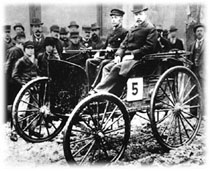 Next
you'll get to meet a few of the automobile inventors whose names and
work have made it into the next century of car history: Ford and Chrysler.
Next
you'll get to meet a few of the automobile inventors whose names and
work have made it into the next century of car history: Ford and Chrysler.
Your first stop is The Henry Ford exhibit hall of Innovators to meet Henry Ford. Read about his childhood, his life as an engineer and his making of the Ford Motor Company. Also review the Chronology of his life and the Quick Facts, checking out the historic photos on the right of each page. How did Ford's expertise and vision as an engineer drive his dream of producing affordable motor vehicles?
Next hit the Showroom, and browse the gallery of cars that influenced automobile history from the 1896 Quadricycle to the Model T to the 1949 Ford, 1965 Mustang and 1986 Taurus. How did each of these models both reflect and influence the time period during which they were produced? How did the design of the exterior and of the engine change over time? How did their reception by the public, or the government, affect their success?
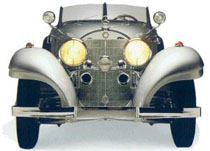 Now
move onto another automaking company, Daimler-Chrysler, to read about
its Heritage,
focusing on the History of Chrysler beginning with
The
Early Years. In each era, you can click on the event titles
to learn more about them.
Now
move onto another automaking company, Daimler-Chrysler, to read about
its Heritage,
focusing on the History of Chrysler beginning with
The
Early Years. In each era, you can click on the event titles
to learn more about them.
As you travel forward in time, you'll explore The Birth of the Chrysler Corp. in 1924, The War Years of 1938-1945, the Tailfins and Turbines of the late 1950s and 60s, and how it is A Leader Once Again with its more recent push in the automotive markets and its 1998 merger with Daimler-Benz.
How did Chrysler and Ford adjust with the times? For example, how did they respond to the Great Depression, World War I and II, and the competition with other automakers for consumers? How do you think the art and science of Chrysler and Ford vehicles reflected consumer tastes and evolving lifestyles?
Hit the Highway
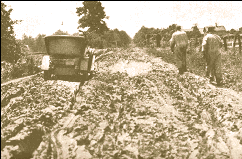 Time
to take a Model
T Road Trip, courtesy of the Ford Motor Co., to get an
idea of what buying a car and traveling cross-country was like in 1919.
Begin
the journey, moving through Jenny's journal using the Next
buttons on the lower right of each page. Click on any red,
underlined text in her journal to read more about that topic, then click
Back to return where you left off.
Time
to take a Model
T Road Trip, courtesy of the Ford Motor Co., to get an
idea of what buying a car and traveling cross-country was like in 1919.
Begin
the journey, moving through Jenny's journal using the Next
buttons on the lower right of each page. Click on any red,
underlined text in her journal to read more about that topic, then click
Back to return where you left off.
Why was Jenny's father hesitant to buy a car at first? What changed his mind? How did getting a car affect the daily life of each family member? What were the roads like and who was in charge of their maintenance? How and how often did the family pump gas into the tank? What aspects of this 1919 journey are different from or similar to buying a car and taking a road trip in 2003?
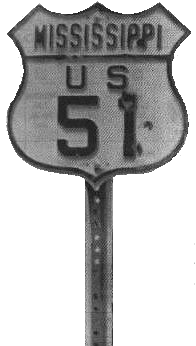 Of
course, many aspects of American life and our cars have changed since
1919. Many of the changes relate to the evolving technology and design
of the cars themselves, but others relate to the condition and connectedness
of the roads we can travel.
Of
course, many aspects of American life and our cars have changed since
1919. Many of the changes relate to the evolving technology and design
of the cars themselves, but others relate to the condition and connectedness
of the roads we can travel.
Although the need for smoother roads had been acknowledged, government agencies soon recognized the need for a well-ordered system of roads. Such a structure was critical for efficient trade, citizen safety and military deployment.
Take another road trip, this time to Historic California U.S. Highways. Read the Introduction, then go to the History section. What federal legislation in 1925 created the U.S. Highway System? How did cheap oil and concrete fuel the car boom? How did the Interstate Highway Act in 1956 change the importance of these two-lane roads?
Also read about the 1928 Highways and the 1964 Renumbering. You can also browse the Highway List to discover how these highways were created or have changed. Why did some road numbering cause confusion for motorists? How was this situation in California and other western states different from that in eastern states?
Your last stop is the Federal Highway Administration's National Highway System (NHS) site. Read about the different components of the NHS, check out the map of highways, and read the article titled, The National Highway System: A Commitment to America's Future. How many miles of highway exist and what percent is still in the works? What proportion of the nation's traffic do highways carry compared to all other roads? In what ways does the highway system serve the American public? How do the road system and our love affair with the automobile continue to shape our daily lives and our national, regional and local cultures?
Newspaper Activities
In a current issue of Targetnewspaper track down articles about cars or travel. If you find stories about specific cars, what automaker produces them? What features of the vehicle's engine, exterior and interior design, or its options and price range make it attractive to consumers? What kind of gas mileage does it get? Does it provide four-wheel drive or air conditioning? What type of consumer would purchase this vehicle? If the article is about a car show or race, what kinds of cars does the story highlight and why?
If you come across stories about sites to see along America's roadways, is the attraction in a small town or big city? What route using highways would you take to get there from where you live? How does that compare with a travel route using roads that aren't highways? Where do people live and work relative to highways and other roads? Is there a pattern in this distribution of the population? If the story features news about local traffic problems, what are people suggesting be done to make things better — maybe build new roads, get motorists to use public transportation, or live closer to where they work?
© Copyright 2003
Learners Online, Inc.
